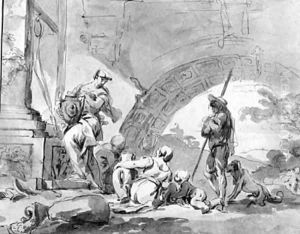Pierre-Joseph Le Mettay Paintings
Pierre-Joseph Le Mettay was a French painter and engraver, known for his contributions to Rococo art, a style that emphasized grace, ornamentation, and asymmetry. Born in 1726 in Paris, France, he was part of a period in art history that saw a shift from the grandeur and seriousness of the Baroque to a lighter, more decorative aesthetic. Despite his relatively short life, Le Mettay managed to make a significant impact on the art world of his time.
Le Mettay's artistic journey began under the guidance of his father, who was also an artist, and later, he became a student at the prestigious Royal Academy of Painting and Sculpture in Paris. His early works were primarily engravings, through which he developed a keen eye for detail and a delicate hand, skills that would serve him well in his later work as a painter. Le Mettay was known for his ability to capture the elegance and frivolity of the Rococo movement, often focusing on themes of love, nature, and playful mythology in his compositions.
Throughout his career, Le Mettay received numerous commissions from the French aristocracy, who were the primary patrons of the arts during this period. His paintings and engravings were highly sought after, and he was known for his ability to blend the traditional with the innovative. Le Mettay's work was characterized by its lightness of touch, intricate details, and the use of soft, pastel colors, which reflected the Rococo taste of the time.
Despite his success, Le Mettay's career was cut short by his premature death in 1759 at the age of 33. The exact circumstances of his death remain unclear, but his legacy lived on through his influential works. Today, Pierre-Joseph Le Mettay is remembered as a talented artist who captured the essence of Rococo art, contributing to the richness and diversity of French 18th-century painting. His works continue to be studied and admired for their beauty and historical significance.
